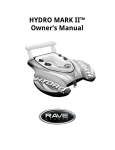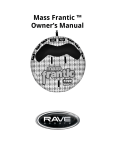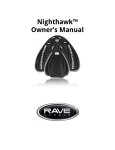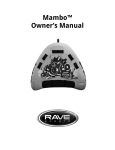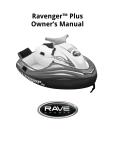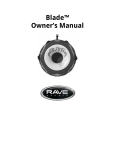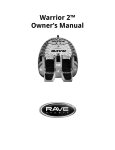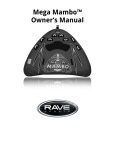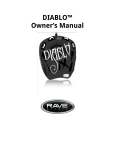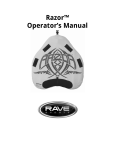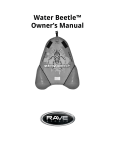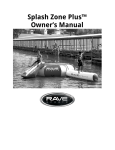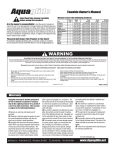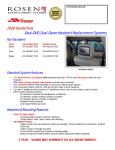Download RAVE Water Sports Equipment User Manual
Transcript
Tirade II™ Owner’s Manual ! WARNING USE OF THIS PRODUCT AND PARTICIPATION IN THE SPORT OF TUBING INVOLVES INHERENT RISKS OF INJURY OR DEATH. 1. This tube is designed to carry no more than two persons or 340 lbs 2. Use a tow rope of at least 2,375 lbs. average tensile strength for pulling this tube and its riders. 3. Read Operator’s Manual before use. Do not remove warning. Product Instructions and Warnings To reduce the risk of injury or death using this tube, follow these guidelines: • Carefully read this manual and follow the instructions. • Only use your tube with a responsible watercraft operator who knows how to operate a watercraft properly • Take all reasonable precautions in the use and operation of your tube and boat. • Teach anyone using your tube how to attach it to the rope, how to ride it and how to maintain it. Product Instructions and Warnings (continued) • Do not exceed the manufacturer’s recommended number of riders for your particular tube. • If the tube is designed for more than one person, take extra precaution to avoid colliding with one another. • Never strap or attach anyone to the tube or cover. Never put your feet or hands through the strapping of the towing system or handles. Never wedge your hands or feet under the cover or between the cover and the tube. • Never attempt jumps or dangerous tricks with your tube. If more than one tube is being towed, avoid collisions with other tubes. • Scout the area before use to avoid any debris or obstacles that might present a safety hazard. • Know your own limits. Stop when you are tired. Act responsibly. Be in good physical condition and cautious in your use of this or any other towable tube. • Check the rope and connectors for frays, cuts, sharp edges, knots, or wear before each use. Discard rope if any such condition exists or if rope appears to be worn. Such conditions may lead to breaks. • Do not use a tow rope with elastic or bungee material to pull riders unless it is specifically designed for tow tube use. • The stress on the rope is different than the stress on the tube, and will vary with the weight of the riders, design and surface area of the tube. • Rope is subject to deterioration when exposed to direct sunlight. The life of the product will be extended when stored away from sunlight. Product Instructions and Warnings (continued) • The tow rope should be replaced when signs of deterioration appear, indicated by the existence of discoloration, wear, fraying or unraveling. • Do not add hardware or attachments that are not otherwise supplied by the manufacturer. ! WARNING USE OF THIS PRODUCT AND PARTICIPATION IN THE SPORT OF TUBING INVOLVES INHERENT RISKS OF INJURY OR DEATH. ! WARNING Do not use at speeds that exceed the skill of the rider. Boat speed should never exceed 20 mph for adults and 15 mph for children. This product should never be used by children except under adult supervision. This is not a personal flotation device. Always wear a U.S. Coast Guard approved Type III (PFD) vest. Never place wrists or feet through handles or towing harness. Ensure tow rope is clear of all body parts prior to or during use. Rider should keep feet out of the water. Watercraft driver is responsible for the ride since the tube cannot be controlled by the rider. Always have a person other than the driver observing the rider. Watercraft driver should avoid excessive speed or sharp turns which might cause the tube to flip over abruptly, resulting in serious injury to the rider. ! WARNING Do not tow in shallow water or near shore, docks, pilings, swimmers or other boats. Do not exceed the manufacturer’s recommended number of riders for your particular tube. Use a tow rope of at least 1,500 lbs. average tensile strength for pulling a single person; 2,375 lbs. average tensile strength for pulling two people; 3,350 lbs. average tensile strength for pulling three people; and 4,100 lbs. average tensile strength for pulling four people on an inflatable tube. The tow rope should be at least 50 feet in length but not to exceed 65 feet. Do not operate watercraft or ride under the influence of alcohol or drugs. Read Operator’s Manual before use. Water Sports Responsibility Code Water sports are fun and challenging but involve inherent risks of injury or death. To increase your enjoyment of the sport and to reduce your risks, use common sense and follow these rules: Before you start: Familiarize yourself with all applicable federal, state and local laws, the risks inherent in the sport and the proper use of the equipment. Know the waterways. Always have a person other than the boat driver as an observer. Rider, observer and driver must agree on hand signals. Never start out until rider signals he/she is ready. Observer and rider should maintain eye contact. Carbon Monoxide (CO) poisoning from engine exhaust may cause injury or death. Do not sit on the boat transom or swim platform while the engine is running. These activities may lead to excessive CO exposure which may cause injury or death. If you can smell engine exhaust while in the boat, do not stay seated in that position for prolonged periods. Never “Platform Drag” by holding onto the swim platform or be dragged directly behind the boat. An improperly tuned engine will produce excessive exhaust. Have your engine checked and corrected by a mechanic. Changing boat speed or direction relative to the wind can reduce or increase boat exhaust from accumulating near the boat and rider. Consult your boat Owners Manual, or the United States Coast Guard’s website: www.uscgboating.org for more information on how to help protect others and yourself from the dangers of CO poisoning Use caution and common sense. Your equipment and your tow rope: Inspect all equipment prior to use. Check tube and attachment point and flotation device prior to each use. Do not use if damaged. Always wear a U.S. Guard Type III (PFD) vest. Ropes should be attached to the watercraft in an approved fashion with hardware designed for pulling. Refer to your watercraft manual for instructions on proper tow rope attachment. Tow ropes stretch during use. If a rope breaks or is suddenly released, it can snap back into the watercraft. Warn all riders and occupants of the danger of the rope recoil. When in the boat, keep away from the tow rope to avoid injury. Passengers can be hit or become entangled in the rope. Inspect tow rope and its attachments before using. Do not use tow rope if frayed, knotted or damaged. Replace when signs of excessive deterioration are indicated by discoloration, broken filaments, unraveling or other obvious signs of wear on the rope or hardware. Use proper tow rope for the activity. Ensure rope is clear of all body parts prior to starting out or during use. Keep persons and ropes away from propeller when engine is running, even in neutral. Should rope become entangled in propeller, SHUT OFF ENGINE AND REMOVE IGNITION KEY BEFORE RETRIEVING ROPE. When You Ride: Attempting land or dock starts can increase the risk of injury or death. USE THIS PRODUCT ONLY ON WATER. Always remove any slack in the rope between watercraft and rider before starting. Sudden shock loads may cause injury to the rider or failure of rope, resulting in snap-back or breakage. Do not ride in shallow water, near shore, pilings, docks, rafts, swimmers, other boats or other obstacles. Such obstacles are examples of risks that are inherent in the sport. The driver and rider must watch for and be able to stop or turn to avoid obstacles. Always ride in control and at speeds appropriate for your ability. Ride within your limits. Follow instructions on tube for safe speed limits. Do not ride over ramps or jumps. Falling and the injuries that may result are inherent risks in the sport. Use a flag to signal to others that a rider is in the water. Driver must use extra caution approaching fallen rider and keep eye contact on fallen rider at all times. Put the boat in neutral when near a fallen rider. Turn the engine off when people are getting in or out of the boat, or while in the water near the boat. Do not operate watercraft or ride under the influence of alcohol of drugs. Inflating Instructions CAUTION: DO NOT OVER-INFLATE. Use of an air compressor or over-inflation can rupture the tube beyond repair, thus voiding the warranty. Step 1 Lay Tirade II on a flat surface. Make sure there are no sharp objects under the product that might puncture the tube. Step 2 Remove the fiberboard insert from the rooster tail device. Note: It is highly recommended that you keep this insert to place back into the rooster tail device during storage. Doing so will help maintain the shape of the device. Step 3 Locate the clear stem valves for the floors. Inflate floors first. NOTE: Moisten the plug of the clear stem valve prior to inserting into the valve and push plug down into the valve body fully. Step 4 Locate the clear stem valves for the headrests. Inflate headrests second, making sure nylon cover is pulled down and fitted securely around headrests. Inflate the main chamber last. Check cover positioning during inflation and adjust if necessary. Step 5 Attach a properly rated tow rope (not included). Important: Loop end of rope MUST pass through hole of the quick-connect prior to wrapping loop around hooks. Inspect condition of molded tow point prior to each use. Do not use if it shows signs of damage, cracking or breaking. To Deflate: • Unscrew entire valve body from base. Towing Recommendations For best performance and stability in turns, rider weights should be as equally balanced as possible. Note: To avoid damaging the rooster tail device: • Do not drag the product on the ground. • Do not store product in excessively hot area. • Do not tow or sit in the product while it is in contact with the ground. • Avoid extreme shallow water starts as the weight of the rider(s) can depress the rooster tail device into the lake bottom causing damage during takeoff. Troubleshooting Air chamber(s) won’t hold air: • Check stem valves to ensure plugs are fully seated down into the valve body. • Check main Boston valve to ensure plastic ring is not caught under the seal or cap. • Check for holes in bladder following the procedures in the “Repair” section. Cleaning and Storage When the inflatable product is not being used, we recommend that you store it in a covered, shaded area. This will help protect it against ultraviolet (UV) rays and extend the life of the product. Clean the inflatable completely with a mild soap and fresh water. NEVER USE PETROLEUM BASED PRODUCTS OR SOLVENTS FOR CLEANING. Product should be completely dry and remain dry while stored. Replace the insert into the rooster tail device. Roll the product loosely and place in a vented storage bag or container. Store in a cool, dry location. Do not store product directly on concrete surface. Place mothballs around stored inflatable to keep mice and insects away. Secure the product to prevent unauthorized or unsupervised use. Repairs For Minor Holes or Tears: Remove the inner bladder from the cover. Inflate the tube and locate the leak by spraying the tube with soapy water. Bubbles will appear where there is a leak. Determine the hole size and cut a circular patch ½ - 1 inch wider than the hole. Remove air from the tube and dry tube completely where the patch is to be applied. Peel off paper back from patch, apply repair patch to area and work out any air bubbles from beneath the patch. Apply weight to the patched area for one hour before reinflating. Put the bladder back into the cover. NOTE: Ensure the outer edge seam of the bladder is aligned with the cover seam and is spread out evenly within the cover. A misaligned cover can cause distortion and less than optimal performance of the tube and rooster tail. For Other Repairs: If the tip of the rooster tail device becomes bent, apply medium heat with a hot air gun or blow dryer and restore the shape. Install the fiberboard insert that came with the device. Let cool. RAVE Sports Raft Water Sports












